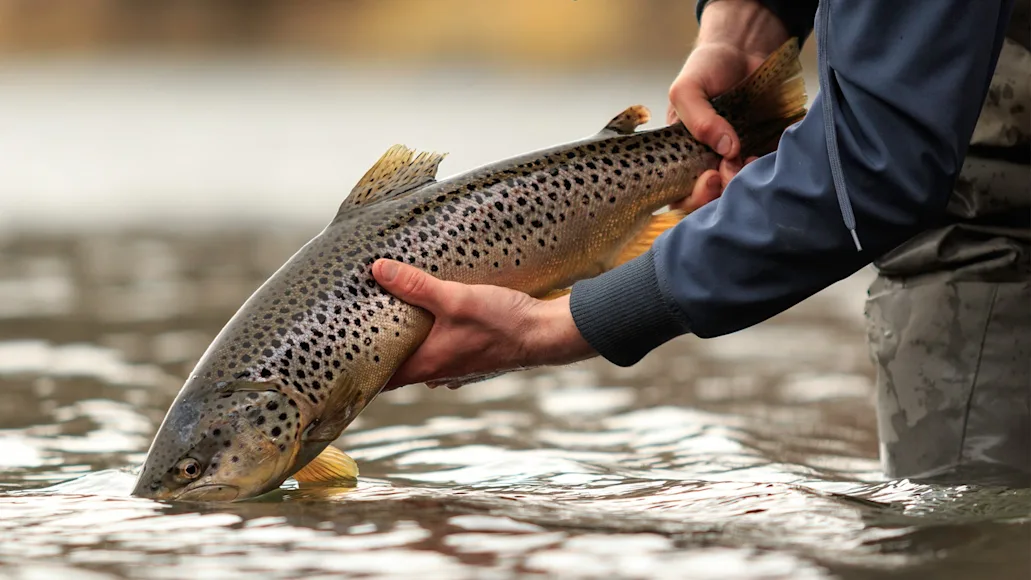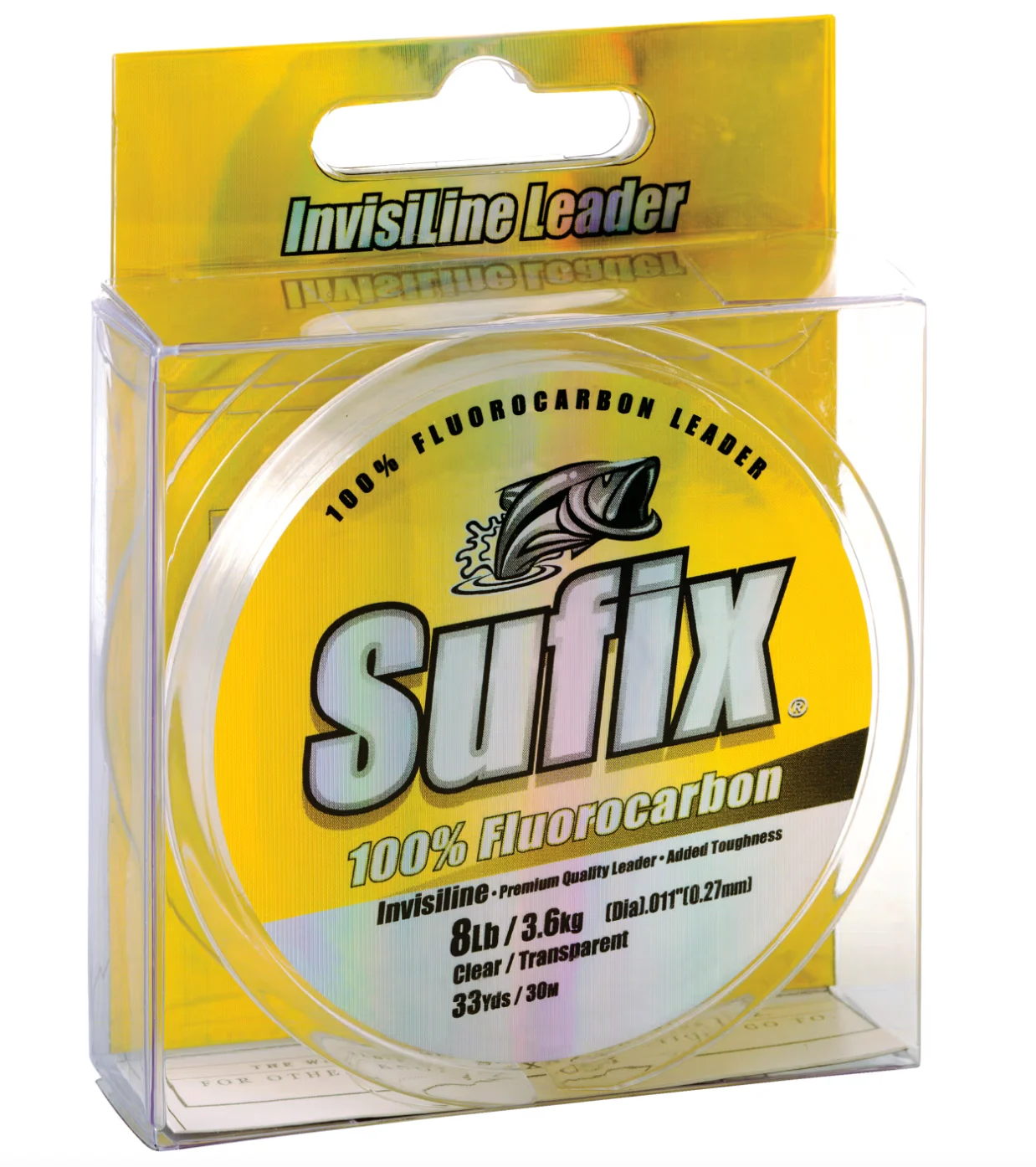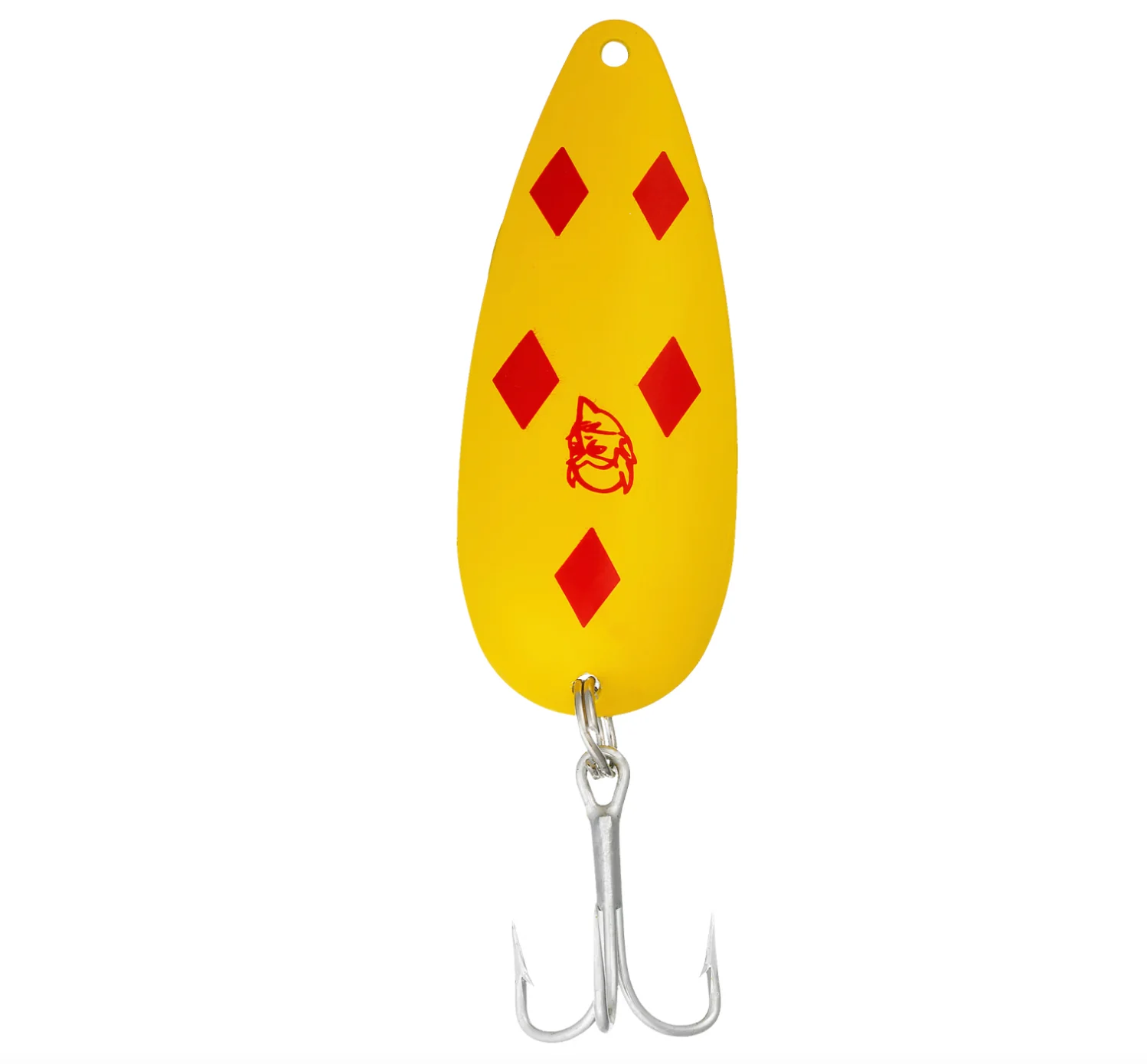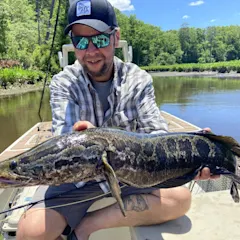We may earn revenue from the products available on this page and participate in affiliate programs. Learn more ›
Maybe your best option for catching trout is a stocked stream that only affords the opportunity in spring and fall. Maybe you’re lucky and live in a region teaming with wild trout streams that run ice cold year-round. The good news is that regardless of where you’re trout fishing, the spinning gear you need and tactics you’ll employ won’t change. One of the greatest things about spin fishing for trout is that it’s minimalistic compared to chasing other species like bass or muskies. Most of the time, a few lures in your vest pocket or a few hooks and weights are all you need to be successful. The key is figuring out exactly which ones you need based on the type of water you’re fishing. This guide to spin fishing for trout will help you select the perfect rod, reel, line, lures, and baits, and help you put them to good use no matter where you live.
Table of Contents
The Gear You Need
Stillwater Vs. Rivers and Streams
How to Fish the Top Lures
Inline Spinners
Spoons
Soft-plastic Jigs
Hard Jerkbaits
How to Rig and Fish the Top Baits
Garden Worms
Mealworms
Dough Baits & Salmon Eggs
10 Expert Tips to Land More Fish
Spin Fishing for Trout: The Gear You Need

Many spin fishermen hunt for trout in smaller, wade-friendly streams and rivers. These waters are usually pretty easy to dissect, meaning you’re targeting specific runs, holes, and pockets within them versus making long casts and covering vast swaths of water. In many instances, you’re also competing with overhanging limbs and bushes that reduce casting room and make casting accuracy important. For these reasons, a 5 ½- to 6 ½-foot light to ultra-light rod is ideal for spin fishing for trout. Shorter rods will not only let you work in tighter quarters, but they’ll also do a better job of delivering light lures like in-line spinners, small jigs, and lightly weighted natural baits accurately.
Spooling up with the proper line also aids in accurate delivery, as a common mistake is using too heavy of a line to cast such light lures. I use 2- to 4-pound test fluorocarbon on all my small-stream outfits. Though braided line might be all the rage these days, I don’t believe it offers any advantage for stream trout, but the disappearing properties of fluorocarbon certainly help you score more wary fish. Assuming there are some bigger trout lurking about, it’s worth using a reel with a quality drag, as scaling down to 2-pound-test line can require you to be deft during a battle with a big fish. The 1000-size Shimano Stradic is one of my favorite small stream reels.
If, on the other hand, you spin fish for trout in bigger rivers or lakes by foot or by boat and you need to cover more water, I’d recommend stepping up to a 7- to 7 ½-foot medium action spinning rod and a mid-sized reel. In general, larger rivers also hold more trophy trout, which means you often want to step up lure size as well. Whereas a small spinner might cover a pocket-water stream effectively, it won’t cover very well—or attract as much attention—in a big body of water. So, upsize those spinners to something heavier like a Blue Fox Vibrax or throw larger jerkbaits like a Smithwick Rattlin’ Rogue , as these waters also usually feature larger forage species than smaller streams. A slightly beefier outfit will deliver these offerings most effectively, and in big water, braided line becomes more beneficial. I like 15-pound braid when spin fishing for trout, as it does a better job of setting hooks at a distance. I’ll add a 3-foot length of 12-pound fluorocarbon leader to the end of my braid for abrasion protection and to make my lures look more natural.
Spin Fishing for Trout: Stillwater Vs. Rivers and Streams
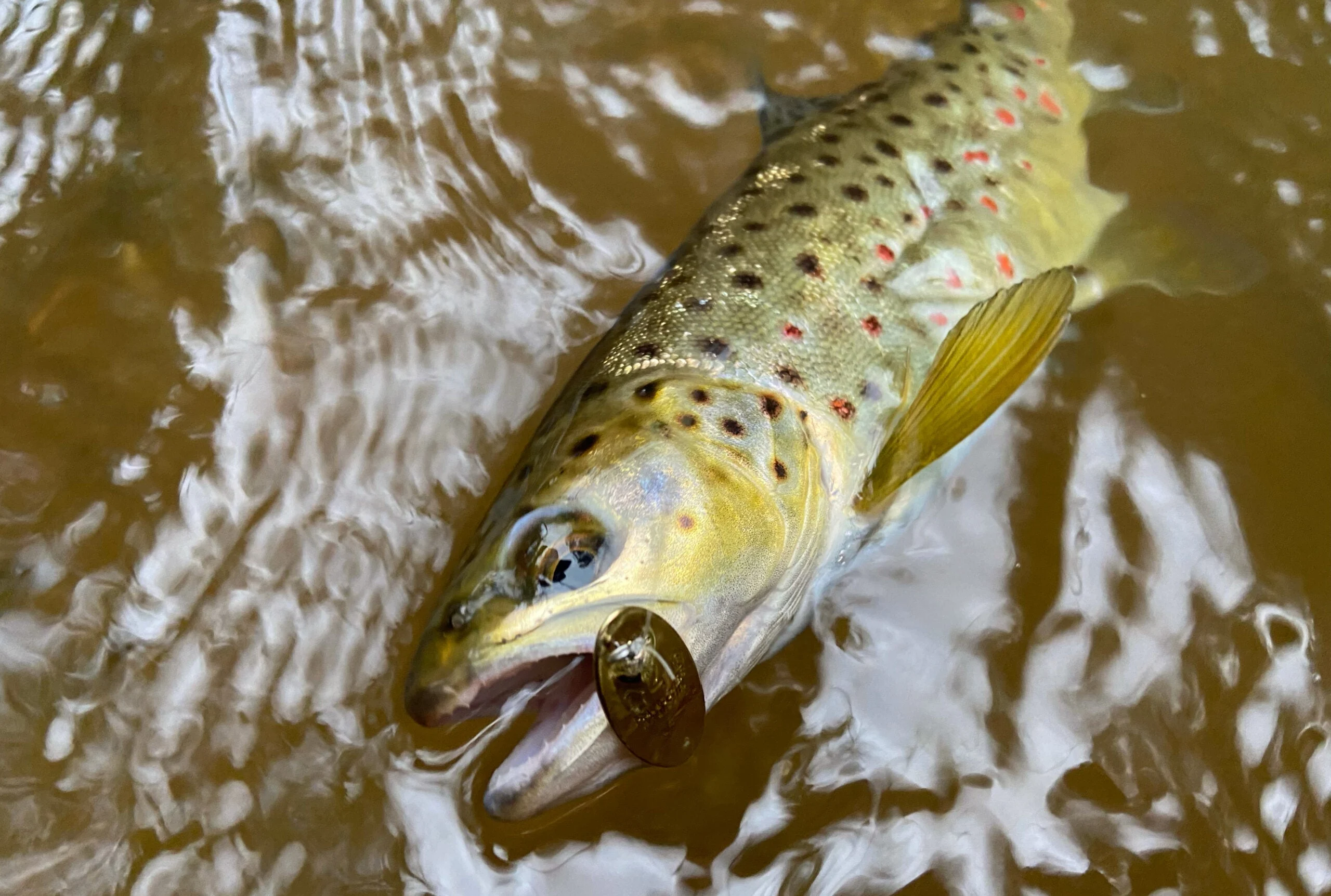
Everything from a tiny spring-fed pond to a huge, sprawling lake can hold wild or stocked trout. These fish thrive in still water, and targeting them in these places is easier on one hand but more challenging on another. Without current to force them into certain positions, trout in still water just sort of roam around feeding. This can make them tougher to pin down. On the other hand, it means you can cast your bait or lure in any direction and potentially connect. As soon as start spin fishing for trout in moving water, however, the approach changes.
Trout in rivers and streams will always be facing upstream or into the current at rest. They do this as a matter of efficiency, waiting patiently for the flow to carry aquatic insects or baitfish right to them. With that in mind, it’s important to consider how the bait you’re casting—or the forage your lure is representing—would naturally behave in the water.
As an example, if you were drifting a mealworm or salmon egg, you’re going to want to cast upstream of the target area and let the current carry the bait down to the fish. Depending on the speed and depth, you’ll want to add or subtract split shot sinkers to your line to try to match the speed of natural forage riding the current as closely as possible.
When working lures, a direct downstream presentation isn’t usually the best, though, as it’s hard to control the action of the lure while also compensating for the speed at which it’s coming directly at you. Most of the time, a cross-stream presentation is better. Cast upstream and across from the target area so you have enough time to get a jerkbait jerking or a spinner blade spinning and allow the lure to swim across the zone as it is simultaneously being carried downstream. This presentation also gives trout a full side profile view of your lure, increasing the odds of it being seen and hammered.
In some cases, an upstream retrieve can be highly effective, particularly with lures that mimic baitfish that would be larger and powerful enough to swim against the flow. Retrieving a spoon, spinner, or small jerkbait upstream through a juicy pool or run often triggers huge strikes from big trout. The tactic works especially well in higher, off-color water.
Spin Fishing for Trout: How to Fish the Top Lures
In-Line Spinners

In-line spinners are made up of a series of beads, blades, and weighted bodies that are threaded onto a stiff central post with a single treble hook positioned at the rear. They’re available in a huge range of colors, sizes, and styles, with brands like Mepps and Panther Martin being popular for small-stream trout and the Blue Fox Vibrax shining on bigger rivers and lakes. Regardless of make and model, all in-line spinners function the same. When reeled in, pressure created from water resistance gets the blade spinning quickly. This not only creates flash, but it also sends out a vibration trout can feel.

In-line spinners can be retrieved at almost any speed while spin fishing for trout, but one of the most effective ways to fish them in moving water is to let them sweep in an arc. Position yourself just upstream of the hole or run you’re targeting. Start by making a short cast just upstream and across from the zone. Reel just enough to get the blade spinning and stop. As the lure is swept into the main current, the water resistance will keep the blade rotating. Simply keep pressure on the lure with the rod and allow the current to swing the spinner across the zone until your line straightens out downstream. If you didn’t get blasted, make your next cast slightly downstream of the first and repeat the process. Continue working downstream making longer and longer casts until you’ve swept the spinner across the entire area.
Spoons
Spoons are very aerodynamic, which is one reason why they’re great for big rivers and still waters where long casts are advantageous. Furthermore, in deeper lakes and ponds, they’ll get smacked as they’re falling to the bottom, since they’re designed to wobble and flash on the drop. After firing out a spoon, always let it fall on a tight line for a few seconds before beginning your retrieve and pay attention for subtle ticks in your line. Like in-line spinners, spoons can be retrieved at any speed, and one of the most popular models for big water is the classic Dardevle.
For the small-stream spin fishing, models like the Phoebe and Thomas Buoyant are tried-and-true. They can be presented just like an in-line spinner by casting upstream and across from your target area and reeling them through the zone perpendicular to the current. In deeper holes and runs, you can also try working a small spoon like a jig. Cast upstream, let the lure hit the bottom, and then snap the rod tip up to make the spoon rise and flutter back as the current carries it downstream.
Soft-Plastic Jigs
Over the last few years, soft-plastic jigs have grown more and more popular when it comes to spin fishing for trout. That’s partially because technology has allowed manufacturers to produce some very impressive, lifelike baits that imitate smaller trout-sized forage. The Trout Magnet, LunkerHunt May Bug, and Clay Bank Mayfly are just a few examples of modern baits that have quickly become staples in the trout game. These baits, of course, also catch loads of fish.

Given that most of these small soft-plastics mimic aquatic insect larva and little worms, they need to be presented like natural bait. One of the most effective ways to do this is to rig one on a small jighead and position it below a small float. Cast the rig upstream of the target area and let it drift into the zone, keeping an eye out for the float to stop or dip. I like to do this with my reel’s bail open so I can feed out line if necessary and stop the rig from dragging.
In larger rivers and lakes, paddle-tail swimbaits have also grown very popular for trout, with the Keitech Fat Swing Impact and YUM Pulse being top producers. These lures can also be threaded onto a jighead, and when rigged this way become very versatile. You can simply cast and retrieve steadily, allowing the tail to emit vibration. That tail, however, will also kick away on the fall, so don’t hesitate to hop a soft-plastic swimbait across the bottom as it drifts through a run.
Hard Jerkbaits
Unlike some other popular trout lures, hard jerkbaits can be fished with finesse. You have more control over their action, which means you can make them pause, twitch, hover, and change direction and speed. Diving jerkbaits feature a plastic lip that drives them to a set depth when you whip the rod tip, and although they’re most associated with fishing bigger waters, they crush on small streams as well.
The trick is simply matching your jerkbait size to common forage in the stream. My favorites for spin fishing wade-able waters are the 2 ¾-inch Yo-Zuri Pin’s Minnow and the 2 ½-inch Rapala X-Rap. These baits do a great job of matching the darters and sculpins frequently present in trout streams. I especially love them when fishing boulder-strewn pocket water, as I can keep one of these micro jerkbaits twtiching in the soft spots behind rocks longer than I could keep a jig or spinner in the same zone.
For larger lakes and rivers, my go-to trout lures are the Smithwick Rattlin’ Rogue and Megabass Vision ONETEN. These bigger baits do a terrific job of matching forage like chubs, suckers, and juvenile trout that trophy trout pounce. When you need to cover a lot of water when spin fishing for trout, aggression is a plus. Cast out and work these lures back with violent rips of the rod tip to get them darting and flashing. Even from a distance, the action of these lures won’t go unnoticed, and when one gets blasted, it won’t be subtle.
Spin Fishing for Trout: How to Rig and Fish the Top Baits
Garden Worms

Like many fish, trout won’t hesitate to snatch up garden worms. In moving water, you can fish them exactly like a mealworm, though keep in mind that garden worms aren’t quite as durable. While it might be tempting to thread a whole worm on your hook, trout don’t have massive mouths. They’ll grab the long end of your dangling worm and rip it clean off, so using smaller pieces of garden worms is often the better option.
If you’re fishing still water, you can fish worms on what’s called a distance rig or high-low rig, which positions a small casting sinker on the bottom and the hook above the sinker. Using a device called a worm blower, you can inject your garden worms or worm pieces with air so they’ll float up off the bottom and become more visible.
Mealworms
Mealworms are one of the best all-around trout baits you can use for trout, particularly in smaller streams. These moth larvae naturally represent a wide array of forage from stoneflies, to grasshoppers, to inchworms, and beyond. Their bright orange color also makes them highly visible, helping them stand out even in off color water. They’re tough exterior body also makes them durable, helping them to stay on the hook better than other baits.
The most effective way to present a mealworm is to keep it simple. Thread one on a size 10 hook, then crimp a split shot sinker 6 inches above the hook. The objective is to have the split shot just barely ticking across the bottom as your bait rides the current downstream. Keep a finger on your line close to the reel so you don’t miss any subtle takes.
Dough Baits & Salmon Eggs
When Power Bait dough was introduced to the market in the late 1980s, trout fishing changed forever. Available in a wide range of colors, this stinky putty soon become standard issue for anglers chasing stocked trout. Though some forms came pre-molded into tiny pellets or salmon-egg shapes, the jars of raw dough allowed fishermen to form a bait into any size they needed.
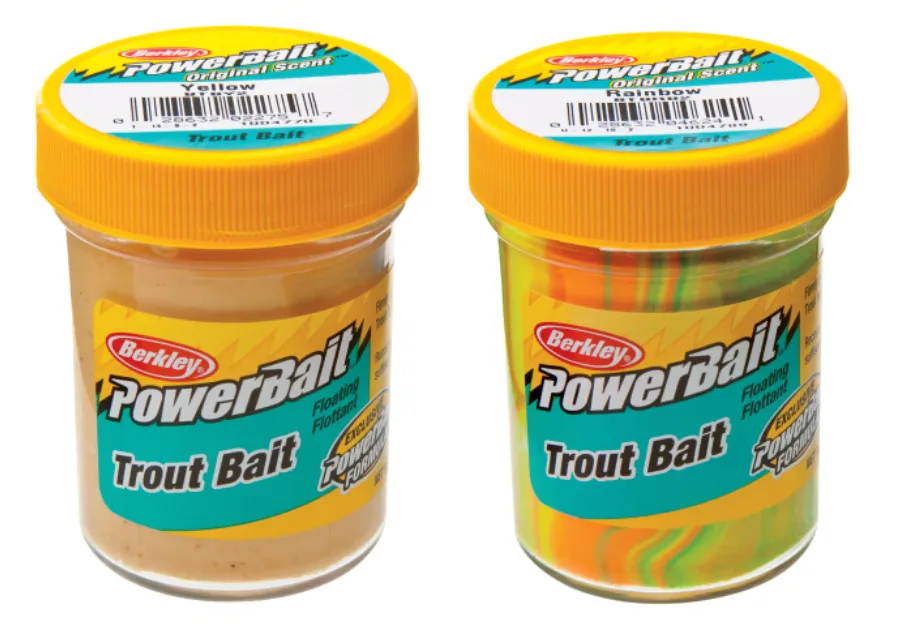
Berkley PowerBait is so effective that it changed trout fishing when it was introduced. Bass Pro Shops
Unlike worms, dough baits play more heavily on scent. Though they can be drifted in moving water, they arguably work best when cast an left still, allowing the dough to slowly melt and create a scent trail.
Similarly, scented natural salmon eggs are popular all over the country, and they’ll get gobbled up by trout that have not and will not ever encounter salmon eggs in the wild. Many salmon egg bottlers scent them with cheese, garlic, or shrimp oil. This allows them to be effective when cast out and left still, but their bright colors and bite size make them equally potent when drifted past trout at a faster clip.
Whether you’re using a high-low rig or just presenting them behind a few split shots, doughs and eggs should be fished on egg hooks. These tiny, short-shank hooks feature a barb that helps these soft baits stay put, and they’re small size allows them to be completely hidden inside the bait.
Spin Fishing for Trout: 10 Expert Tips to Land More Fish
1. Work upstream.

Because their eyes are located on the sides of their heads, trout enjoy an ultra-wide-angle view of the world. Fortunately for us anglers, that view doesn’t extend all the way to the rear.
Knowing that, and knowing that trout almost always face upstream into the current, I approached the big rainbow’s suspected lie from directly downstream. The tactic worked. Crouching low, I was able to approach within 20 feet and make a pinpoint-accurate cast.
2. Cast where others won’t.
That rainbow lay in a deep, swirling gouge behind a wheelbarrow-size rock on the river’s far bank. Apparently, few fishermen ever bothered to wade the pool’s chest-deep waters to get into the proper position to cast to that enticing little pocket.
Don’t be lazy. Go to the trouble, even if it means wading a little deeper or hiking a little farther than usual. Cast over the sunken log, under the root tangle, or between the overhanging branches. You’ll catch more trout. Bigger ones, too.
3. Lighten up when spin fishing for trout.
Most of the spinfishermen who fished the big rainbow’s pool used line far too heavy to fool the sharp-eyed fish.
The 4-pound-test monofilament I used enjoyed a couple of important advantages over heavier line. First, its fine diameter made it harder for the trout to see. More important, though, its thin cross-section permitted it to cut easily through the water’s surface tension, allowing me to fish much deeper using less weight and a smaller lure.
4. Use a strike indicator.
Because I fish upstream, I sometimes have trouble seeing the subtle line-twitches that signal a trout’s strike.
That’s why I now slide a 2-inch sleeve of brightly colored fly line onto my spinning line about 3 feet above my lure or bait. The bright, floating line acts like a flyfisherman’s strike indicator, instantly signaling the slightest disturbance of the lure’s drift.
When the big rainbow struck, it attacked my lure from the side. Had I not seen the strike indicator dart laterally, I might never have known to set the hook.
5. Lose your one-cent sinkers, not your five-dollar lures.
To get the lure deep enough to attract the rainbow’s attention, I had to use a little additional weight. Had I pinched the split shot directly onto the line, I might have lost the lure and the weight if the shot hung on a rock.
Instead, I left a foot-long tag end on the clinch knot I used to tie the lure to the line, then pinched one size B split shot onto the tag end. Had that shot hung up between the bottom stones, it would have slipped off the tag end with just a little rod-tip pressure, and my lure would have come free instantly.
6. Vary baits according to your quarry.

Stocked trout and wild trout have very different dietary habits. Though they’ll eat most anything a wild trout might eat, stocked trout also can be caught on kernels of corn, dough balls, cheese, putty-like prepared baits, and other concoctions no self-respecting wild trout would even consider eating. Wild trout prefer insect larvae, worms, minnows, crustaceans, and lures that imitate those foods.
The big rainbow, a wild trout, had seen a steady stream of cheese balls and salmon eggs all day long. When my minnow imitation came swimming past his lair, he nailed it.
7. Keep your bait fresh with spin fishing for trout.
A little extra wiggle goes a long, long way toward catching trout. A dried-up worm or a sluggish minnow won’t draw nearly as many strikes as a livelier specimen of the same bait.
That’s why the most effective worm fishermen keep their worms in moss-lined boxes. That’s why the best cricket and ‘hopper fishermen keep their insects in mesh “cricket cages.” That’s why top minnow fishermen keep their baitfish in special perforated-liner buckets or aerated livewells.
8. Feed them something small.
Smart, sharp-eyed fish like trout quickly learn to recognize phonies. You can even the odds by using smaller baits and lures. Use a single worm, not a gob of night crawlers. Use a pea-size hunk of cheese, not half a sandwich’s worth. Use a 1/16-ounce spinner, not a 1/4-ounce model.
Use small hooks, too. A No. 8 is pretty big. A No. 12 is good, a No. 14 even better. A No. 14 treble landed the big rainbow.
9. Remember jigs and crankbaits.
Jigs, crankbaits, and spoons aren’t just for bass. Scaled down to the proper size, trout love them, too. A friend of mine slays both stocked and wild trout on traditional trout flies tied onto micro-jig (1/25- to 1/100-ounce) heads.
Personally, I prefer the convenience of crankbaits. Tiny minnow- or crawfish-patterned imitations are absolutely deadly on wild trout. The aforementioned big rainbow hit the tiniest shallow-diving Rebel then on the market. Since then, several manufacturers have begun producing micro-crankbaits for crappies and trout.
10. Employ magic.
There are a few “magic times” when trout seem to strike with more abandon than usual-at dawn, at dusk, immediately before a storm, and when a stream’s waters have just begun to rise after a hard rain.
If possible, time your fishing trips to coincide with these special moments. As was the case with the big rainbow, which struck during the daylight’s last moments, you’ll likely be rewarded with the trout of a lifetime.

